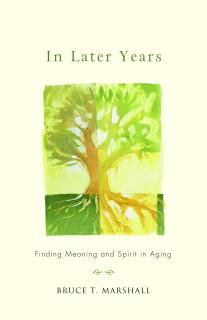Advertisement
As a chaplain in a senior residence community, I see many well-intentioned efforts at helping that come up short or fail outright. Just about all of these can be attributed to the same cause: failing to take into account the person we are trying to help. We let our own needs and desires drive us rather than paying attention to the other.
Roger M., a retired attorney in his early 90s, told a story that had a group of his contemporaries convulsed in the kind of laughter that comes from recognizing a situation as both ridiculous and true. Many of them, it seems, had similar experiences. This man’s story concerned a chair. He had an easy chair where he sat to watch television, read, work on a crossword puzzle, or sometimes just be. He and his chair had been companions for a long time, and over the years it had adjusted to his body. So the two of them—man and chair—fit amicably together. Admittedly, the chair was showing its years, looking shabby, and it wasn’t all that clean anymore. Nevertheless, Roger loved his chair.
Then one day, he arrived home and—the chair was gone! Replaced by a brand new easy chair: beautiful and shiny and equipped with premium features like motorized leg rests and a headrest that tilts into any conceivable position. When you want to sit, you press a button, and the chair rises to meet you. When you want to get up, it lifts and gently sends you on your way.
Give up on the project of ‘fixing’ people or jollying them up and, instead, accept them.
This man’s children had decided that the old chair had to go and so they replaced it, as a surprise. Well. Roger agreed that the new chair was a lot more attractive and had more features than his old chair could have ever imagined. Except . . . it wasn’t comfortable. It hadn’t put in the years necessary to become truly acquainted with its owner. This chair wasn’t his chair.
But it didn’t feel right to complain. His children had delivered the new chair with good intentions. They had wanted to do something nice for their father, and they were actually quite pleased with themselves. In their view, they had rid their father’s apartment of an eyesore and possible health hazard (hard to know what was living in the crevices of that old chair!), and they had transported Roger into the modern age of cutting-
edge easy-chair technology. Each time one of them visited, they could view this exhibit of how much they loved him.
Roger concluded that it would be too grumpy for him to express reservations about this gift, so he smiled and thanked his children. Besides, his beloved old chair was probably residing in a dump somewhere. It wasn’t coming back.
And yet, he confided to this group of seniors who nodded in appreciation of his dilemma, “I hate that new chair!”
In seeking to help another—loved one, friend, or stranger—our actions are guided by our own perceptions of another’s situation in life and what, from our perspective, we think this other person may want and need. Or should want and need. The result might be a new chair—because I certainly wouldn’t want to sit on that old thing. Or pressure to take a pottery class—I would love to learn how to throw a pot, and you should too. Or a surprise party for your next birthday—you’re 90, so celebrate! I’ll want to celebrate if I make it to 90. Or a covert housecleaning—because I certainly wouldn’t want to live that way. We make assumptions about what someone should want and need, and we act on that basis.
This evades the hard work of relationship: taking time to be present to another, listening, sharing one’s own thoughts and feelings in response, asking questions, paying attention to what is said and accepting it, honoring it. In long-term relationships—like that of parent and child—we slip into habits of communication that may rarely stray from familiar patterns that have developed over years and decades. We may have been interacting with each other for forty, fifty, sixty years. It becomes hard to hear anything that doesn’t fit with what has come before.
Instead of building an actual relationship, we insert what we think this person may want and need or what we want and need. For example, we may confront the elderly with an excess of cheerfulness. When you listen to visitors and staff talk to the residents of a retirement community, you could be forgiven for thinking that you’re overhearing a kindergarten class—or a preschool. We speak in unnaturally lively tones, drawing on a vocabulary suitable for the very young. Or we encourage “activity.” Be active! Join clubs! Start a new hobby! Take a course!
In Later Years: Finding Meaning and Spirit in Aging, by Bruce T. Marshall (Skinner House, 2018).
And then there are the publications aimed at seniors that are so resolutely chipper that I can barely read them. They appear to be written by young people who assume that relationships with the elderly should be about perkiness. “Hoof it for health!” shouts one article, on the protection against breast cancer afforded by brisk walking. “Protect your peepers!” proclaims another, on the advisability of taking care of our eyes. Couldn’t we just say, “Take a walk?” and “Wear sunglasses?” Do we really have to get cutesy in order to attract the wandering attention of seniors?
The message that comes through these efforts is our own discomfort with aging. Jeff Watson, the director of operations at Erickson Living observed, “If we as younger people try to make our seniors look happy, talk happy—it’s usually less for them and more for us. We like it better when they’re happy. We think we’re doing a good job when they are happy. We think it’s our job to make them happy. And actually, if they don’t make us happy by acting happy, we’re unhappy with them.”
Many seniors I interviewed for In Later Years admitted that they don’t talk with their children about their deepest concerns because they fear that honesty might upset them. As one woman put it, “Our children don’t want to hear us. It hurts them too much.” And so they protect their children even as their children protect them. The generations don’t connect. We pretend cheerfulness, offer distractions, assure each other that everything is “fine,” because it’s easier and less threatening than actually paying attention to each other.
The essential principle of what does help is simple: be present to other people as they are, not as you want them to be. This means putting aside your own needs and expectations so that you can pay attention to this actual human being who is right here, right now, in front of you. It means giving up on the project of “fixing” people or jollying them up and, instead, accepting them. It means regarding the elderly as human beings. Just that. Treating seniors as you want to be treated yourself: with respect and kindness.
While this is a simple formula, the actual practice can involve considerable trial and error. We will make mistakes, misread situations. We will frequently feel uncertain. This is not a bad thing. The tradition of contemplative spirituality urges us to enter new situations with openness, casting aside preconceptions, becoming “empty” so that we can be present to what is actually before us. Rather than entering with the assumption that we know what is good for the person we seek to serve, we assume an outlook of “not-knowing.” And rather than approaching an encounter with the confidence that we know what we’re doing, we empty ourselves. We become present.
Excerpted with permission from In Later Years: Finding Meaning and Spirit in Aging, by Bruce T. Marshall (Skinner House, 2018).

